Industrial high energy consumers are increasingly opting for the deployment of combined heat and power (CHP) technology in the United Kingdom.
With increasing energy prices resulting from hikes in electricity generation and transmission costs, the United Kingdom is seeing growing numbers of manufacturing and production facilities opting for self-generation of power with the deployment of CHP technology. Key industrial sectors with high power consumption includes food and drink processing, the automotive sector, pharmaceuticals, chemicals and metals processing.
CHP plants are captive power plants that generate electricity, typically from gas, and in-turn recover heat from the generators, either as hot water or steam for local use. Generating power close to the site of use not only reduces losses associated with the transmission of electricity, but also improves total fuel efficiency to around 90%.
Industry Following Early CHP developments in Scotland and Northern England:
In the public sector, universities and hospitals have utilised gas engine CHP technology for decades now. Early installations include Dundee University and the Freeman Hospital in Newcastle. Both of these institutions deployed Jenbacher gas engines over 15 years ago to reduce their fuel consumption. Both have now refurbished the facilities using the latest engine models with even higher efficiency levels. Early district energy schemes were also deployed in cities such as Aberdeen, the colder climate making them prime locations for efficient use of electricity and heat.
Key to successful industrial CHP schemes:
The key to the success of CHP installations is firstly matching the site’s electricity and heating needs to an appropriate generator and heat recovery system. This is done through a detailed technical evaluation of the half hourly energy consumption data, if available. A decision can then be made upon whether hot water or steam would best meet the site’s heating requirements. If the site has a cooling requirement it is also possible to fit an absorption chiller to support refrigeration or air conditioning systems.
The next consideration is the machinery and systems that supports the performance of the core generator. If either the generator or ‘balance of plant’ are inappropriate for the application then operational problems may occur in the future. The final consideration for the success of a CHP installation is the aftersales support. Much like a car engine, CHP engines have scheduled maintenance. For a machine that runs for almost the entire year, it is important to conduct these as per manufacturer’s guidelines and supported by highly trained and equipped service engineers, such as those provided by gas engine specialist Clarke Energy.
CHP evolution:
Recent years have seen a much wider deployment of CHP technology for a range of new applications. Rising fuel costs and a starker ‘spark-spread’ – the difference in the price of electricity and gas – along with a focus on reducing carbon emissions are all important drivers.
London in particular has seen massive growth in CHP technology over recent years. A range of high profile buildings now utilise gas engines for cogeneration including the National Gallery, the Shard, and the Natural History Museum. Deploying the technology supports the cost and carbon reduction drive and is also looked on favourably by planning departments from a sustainability perspective.
District energy in the capital now forms the back-bone of many large new commercial developments. The King’s Cross scheme has two bright pink Jenbacher engines supporting a large district heating scheme supplying commercial and residential properties alike. The engines being painted pink to raise awareness of breast cancer research. The redevelopment of the area around Victoria railway station ‘Nova Victoria’ scheme also is using CHP to reduce fuel costs and carbon emissions.
Hospitals too in London continue to adopt CHP technology with Guys, St Thomas’, Great Ormond Street and Bart’s all utilising the technology as a core to their approach to energy usage. The operational cost focus therefore can be on saving on energy and deploying more resources for patient treatment.
Datacentres are an emerging market for CHP technology. The focus here is on combined cooling and power rather than combined heat and power. Citibank’s datacentre in London is one of the first in the UK to use the technology and can generate 71% of the datacentre’s electricity.
Finally, with the reduction in price of renewable energy technologies such as wind and solar energy along with storage technologies such as batteries, it is possible to integrate these different elements into a microgrid and make an industrial user self-sufficient and minimise carbon emissions.
Summary:
High energy users can move to an off-grid power generation solution using CHP, possibly integrated with other forms of low carbon power. This provides not only reduced operational costs, but also security of power supply, resilience and significant reductions in carbon emissions.
For more information or to request a free energy audit please contact alex.marshall@clarke-energy.com, or Clarke Energy’s sales team on +44 151 546 4446.

